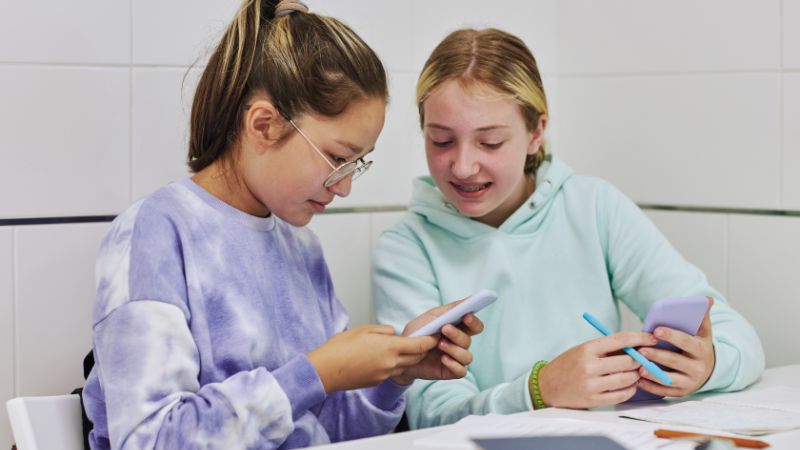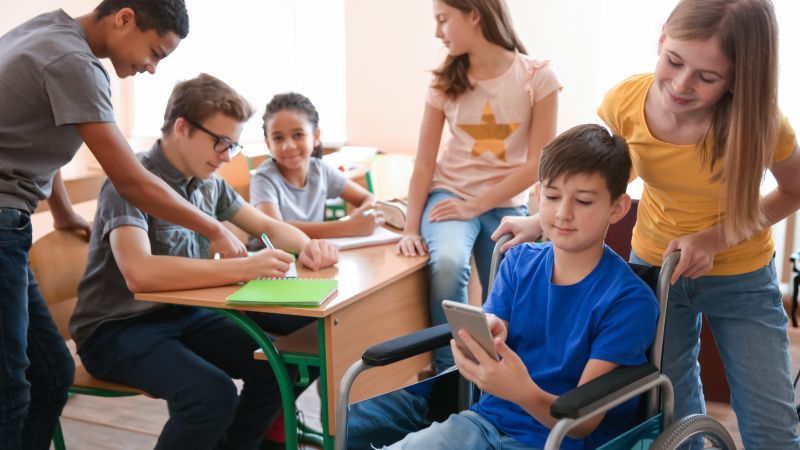The debate about cell phones in classrooms isn’t new. While some schools enforce strict bans, citing distractions and potential misuse, there’s a growing conversation about the benefits of allowing students to have their phones.
Let’s explore why should phones be allowed in school and how responsible use can be fostered.

Why Do Some Schools Ban Mobile Phones?
Concerns often center around:
- Distractions: Phones pulling focus from lessons.
- Cyberbullying: The potential for misuse during school hours.
- Cheating: Using devices inappropriately during tests.
These are valid points, but banning phones outright might overlook significant advantages.
Reasons Why Kids Should Have Cell Phones During School
Instead of focusing solely on potential negatives, let’s delve into the significant benefits students gain from having access to their phones:
Quick Emergency Response
Seconds matter in a crisis. Whether it’s a sudden medical issue (like an allergic reaction or asthma attack), a safety concern on campus, or even a natural disaster impacting the area, a personal phone provides the fastest way for a student to reach parents, guardians, or 911 directly.
Relying solely on school landlines or procedures can introduce delays that might be critical. This direct line offers immediate reassurance and information exchange.
Powerful Pocket-Sized Learning Tool
Forget waiting for the computer lab. Smartphones put a world of information at students’ fingertips.
- Instant Research: Need to quickly look up a historical date, define a scientific term, or find a synonym? A phone makes it immediate.
- Educational Apps: Access to tools like Duolingo for language practice, Quizlet for flashcards, Photomath for checking math problems, or Khan Academy for supplemental lessons enhances learning beyond the textbook.
- Interactive Learning: Teachers can utilize platforms like Kahoot! or Socrative for engaging real-time quizzes and polls, turning passive learning into active participation.
- Multimedia Access: Students can view educational videos, listen to relevant podcasts, or access digital versions of texts and supplementary materials assigned by teachers.
Support for Accessibility and Diverse Needs
For many students, a phone isn’t a distraction; it’s a necessary accommodation.
- Communication Aids: Students with speech impairments might use Augmentative and Alternative Communication (AAC) apps.
- Organizational Tools: Apps providing visual schedules, task reminders, or timers can be invaluable for students with ADHD or executive function challenges.
- Sensory Support: Access to calming music or specific focus-enhancing apps can help students with sensory processing differences manage the classroom environment.
- Medical Management: Students with conditions like diabetes might use apps connected to their glucose monitors, or simply need reminders to take medication.

Staying Connected With Parents and Guardians
Life happens, and plans change. Phones provide a practical link between school and home for everyday coordination.
- Logistics: Confirming a change in who is picking them up, remembering to bring home a specific form, or asking a parent to drop off forgotten lunch money or sports gear can be handled with a quick, discreet text, reducing disruption and reliance on busy school office staff.
- Reassurance: A brief check-in message can ease anxiety for both students and parents, especially during transitions or if a child is feeling unwell.
- Coordination: Arranging study groups or collaborating on after-school projects becomes much simpler.
Foster Responsible Phone Usage
The debate isn’t simply about if phones belong in school, but how. An outright ban might seem simpler but misses educational opportunities and ignores the reality of technology in students’ lives. Conversely, unrestricted access invites chaos.
A middle ground involving clear, consistently enforced policies seems most effective. This could include:
- Designated times or zones for phone use.
- Specific instructional purposes approved by teachers.
- Clear consequences for misuse.
- Integrating lessons on digital citizenship and responsible use.
Pros and Cons of Allowing Phones in School
- Pros: Emergency contact, learning tool access, accessibility aid, parent communication, digital responsibility practice.
- Cons: Distraction potential, potential cheating on assignments, monitoring challenges, and social pressure/inequality.
The benefits of allowing phones—especially for safety, learning, and accessibility—are significant. By establishing clear rules, teaching digital responsibility, and utilizing safe communication tools like JusTalk Kids, schools and parents can work together to harness the advantages of technology while minimizing the risks. The goal should be responsible integration, not just prohibition.

How JusTalk Kids Can Improve Student Safety in School?
For younger students or parents seeking extra peace of mind, JusTalk Kids offers a secure platform where children can only communicate with parent-approved contacts. Features include:
- No Contact from Strangers: Critically, children using JusTalk Kids cannot receive friend requests, calls, or messages from anyone who hasn’t been explicitly approved by a parent.
- Parental Control: Parents use the companion JusTalk or JusTalk Family app to set up their child’s JusTalk Kids account (often via a simple QR code scan) and manage the entire contact list.
- Real-Time Location Sharing: The app allows parents to see their child’s real-time location (with appropriate permissions enabled), which can be reassuring during commutes or school events.
- End-to-End Encrypted Conversations: All personal information, including video calls and messages exchanged within the app, is securely encrypted, ensuring privacy.
- Engaging Child-Friendly Experience: While secure, the app remains appealing to kids with features like customizable themes and fun in-call elements like doodles and stickers, making communication enjoyable within its safe framework.
Using an app like JusTalk Kids means a child can use their phone at school to safely connect with pre-approved family members for check-ins or emergencies, completely shielded from unsolicited contact or the wider risks of open internet platforms.

